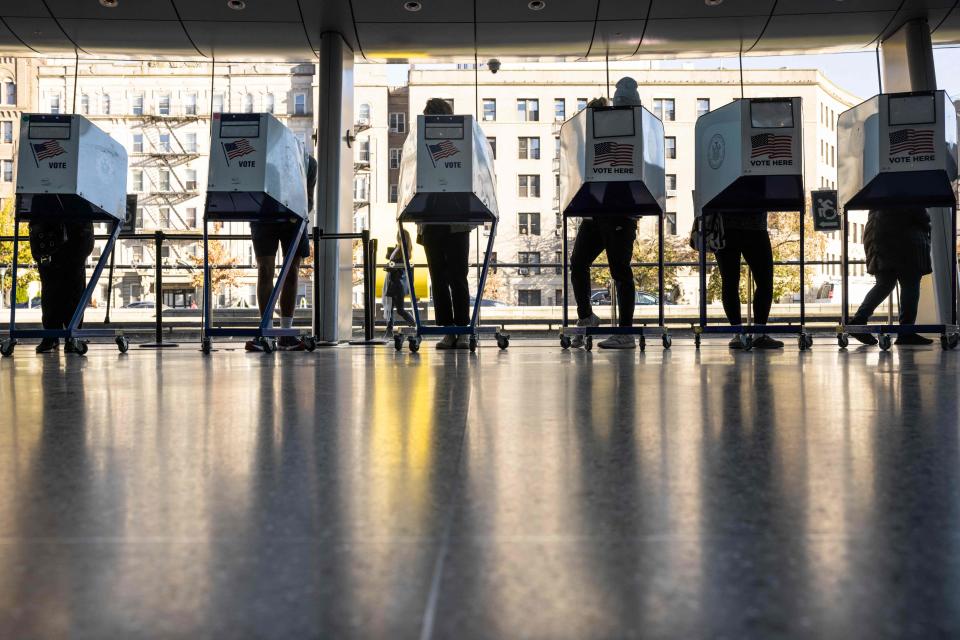The Supreme Court is unexpectedly siding with voting rights groups. Is that the new norm?
- Oops!Something went wrong.Please try again later.
- Oops!Something went wrong.Please try again later.
WASHINGTON – Voting rights groups are cheering a pair of unexpected decisions from the Supreme Court that hold the line on how U.S. elections are conducted, upending predictions that the court's conservative majority might weaken protections for minority voters or give state lawmakers unchecked power to set voting rules.
But the two decisions, while significant victories for groups seeking to maintain the status quo of American elections, set the stage for new showdowns – possibly forcing courts to resolve questions left unanswered in the heat of a politically charged contested election.
At a time when polls show Americans losing faith in elections – and democracy more broadly – the stakes for voters, candidates and the Supreme Court may be higher than at any time since the justices handed down the controversial decision in Bush v. Gore more than two decades ago that effectively decided the 2000 election.
Case tracker Race, religion and debt. Here are the biggest cases pending at the Supreme Court
Here's a look at two major Supreme Court election decisions issued this month and what they might mean for the future.
Power shift: Who can review federal election rules?
Decision: The Supreme Court's decision Tuesday in a case involving North Carolina's congressional map was a repudiation of an argument raised by state Republicans that state legislatures have virtually unchecked power to set election rules. Known as the “independent state legislature theory,” the idea rests on a clause in the Constitution that vests the power to run elections with state lawmakers – and is notably silent about the role played by other branches of state government.
Chief Justice John Roberts, writing for a 6-3 majority, rejected that idea, noting that courts have always been able to review the laws passed by state legislators to ensure they’re consistent with state constitutions.
The case is Moore v. Harper.
Reaction: The decision, which was joined by liberal and conservative justices, was a big win for voting rights groups. NAACP President Derrick Johnson called it a “vital protection against ongoing, malicious attempts to silence Black voters.” Eric Holder, who served as attorney general under President Barack Obama, called it a “victory for our system of checks and balances, the cornerstone of American democracy.”
Caveat: Roberts also wrote that “state courts do not have free rein” to create election rules on their own. His majority opinion left unclear when a state court might cross the line into policymaking. State courts, Roberts wrote, “may not transgress the ordinary bounds” of their role. And that lack of clarity will likely empower losing candidates to turn to federal courts – and ultimately the Supreme Court − to review future election decisions handed down by state courts.
Justice Clarence Thomas zeroed in on that dynamic in his dissent, worrying that the court’s decision would “swell federal-court dockets” with cases that will “arise haphazardly, in the midst of quickly evolving, politically charged controversies,” such as contested elections.
Reaction: Jason Snead, executive director of the Honest Elections Project, which advocates for stricter voting laws, said the ruling would be cheered by the left but that “this is no victory.” The decision, he said, “may wind up being a crucial buffer against the left’s endless campaign to get courts to rewrite election laws for partisan gain.”

Voting Rights Act: Could future challenges over race succeed?
Decision: The high court's surprising June 8 decision that will likely require Alabama to redraw its congressional map upheld how federal courts have long interpreted the landmark 1965 Voting Rights Act. Writing for a 5-4 majority, Roberts said that mapmakers must consider race when they draw districts but should not usually let race be “the predominant factor.”
Alabama’s map included one majority Black district out of seven, even though Black people make up more than a quarter of the state’s population. The Supreme Court rejected Alabama’s argument that a “race blind” approach to drawing congressional districts was allowed if it had such a disproportionate impact on racial representation.
The case is Allen v. Milligan.
Reaction: Lindsay Langholz, senior director of policy and program at the liberal American Constitution Society, called the decision “a welcome reprieve to the Roberts court’s steady erosion of the Voting Rights Act.” Senate Majority Leader Chuck Schumer said it was “a good thing for democracy” that Alabama lost the case.
Caveat: Court watchers have closely parsed a concurring opinion from Justice Brett Kavanaugh in which he flicked at the idea that, even if Congress has the power under the Constitution to “authorize race-based redistricting,” that power “cannot extend indefinitely into the future.” Kavanaugh quickly added that since Alabama officials didn’t raise that argument in their lawsuit, he wouldn’t take a position on it in the current case. But that kind of language is almost certain to invite future challengers to raise exactly that point to see if they can win Kavanaugh’s vote and a majority of the court.
Reaction: The court’s opinion raises more questions than it resolves, Richard Raile, an attorney who has litigated redistricting cases, said earlier this month. “The only thing I can say with certainty going forward is that more litigation will ensue.”
This article originally appeared on USA TODAY: Supreme Court is siding with voting groups but some see warning signs

